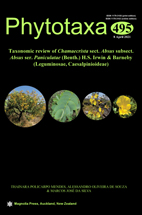Abstract
Chamaecrista (L.) Moench is one of the largest genera of Leguminosae, with about 330 species, 258 of which are present in Brazil, mainly in Savanna areas in the central portion of the country. The genus is monophyletic and comprises six sections, including Ch. cect. Absus, the biggest one with ca. 180 species divided into four subsections and 31 series. Paniculatae series, as traditionally recognized, included 6 species (12 taxa). However, it recently had its circumscription changed from a phylogenetic study that made it a monophyletic group and subordinated 13 species recognized mainly by the generally large leaflets (1.5–9.3 × 1.2–9.5 cm long), orbicular, coriaceous and divaricate, young branches and axis of inflorescences viscous and flowers with posterior petal similar to a standard. Despite this, and considering the recent changes, its species remain scarcely known taxonomically, with typification problems, poorly illustrated and mapped, and without conservation status. A taxonomic review of Ch. ser. Paniculatae, which resulted from monthly collections since 2010, consult the literature and herbaria collections from 26 herbaria, including all types. Thirteen species were recognized, described, and illustrated, represented by images, contrasted by means of a key and commented on morphological relationships, geographic distribution, state of conservation and times of flowering and fruiting. In addition, the updated typification of the group is proposed, including four lectotypifications.

